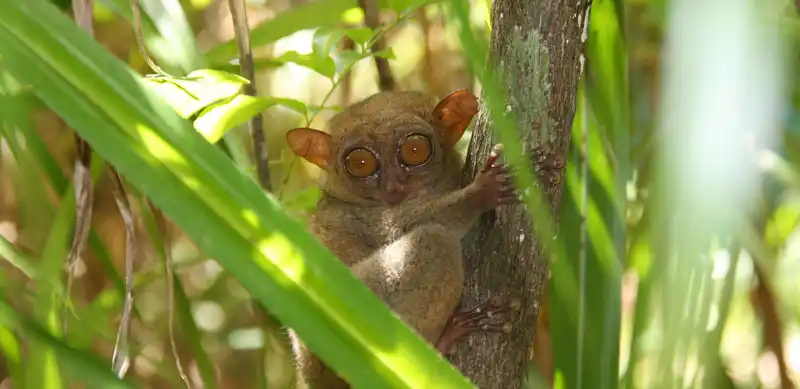The Philippine Tarsier

The Enigmatic Bohol tarsier: A Glimpse into the Lives of the World’s Smallest Primates.
The Philippine Bohol tarsier is located in the lush forest of the island. These tiny primates, with their oversized eyes and peculiar habits, have captured the fascination of locals and tourists alike, making them an emblem of Bohol’s biodiversity and charm.
A Primate of Ancient Lineage
Tarsiers are among the oldest mammalian species, with a lineage stretching back 45 million years. These tiny creatures, measuring only 4 to 5 inches in height and weighing less than 5 ounces, are a marvel of evolution. Their disproportionately large eyes, each of which is as big as their brain, provide them with exceptional night vision, befitting their nocturnal lifestyle.
Unique Features of the Bohol tarsier
What makes the tarsier truly captivating are its distinctive features. Their disproportionately large eyes give them exceptional night vision, allowing them to navigate through the dimly lit forest with ease. These massive eyes are fixed in their sockets, unable to rotate like human eyes, but they compensate by rotating their heads nearly 180 degrees, giving them a wide field of vision.
Aside from their eyes, tarsiers possess elongated fingers and toes, ideal for grasping onto branches as they leap from tree to tree. Their ability to jump impressive distances, up to 40 times their body length, makes them agile hunters, preying on insects like crickets, beetles, and grasshoppers.
The Sanctuary: A Haven in Corella
The Philippine Tarsier Sanctuary, located in Corella, spans over 160 hectares of forested land dedicated to the preservation of these unique animals. The sanctuary not only protects the tarsiers but also educates the public about their delicate nature.
Conservation Challenges for the Bohol tarsier
Despite their adorable appearance, tarsiers are highly sensitive animals. Excessive noise and human interaction can cause them immense stress, leading to adverse health effects. Thankfully, conservation efforts are underway to protect these diminutive primates. Organizations like the Philippine Tarsier Foundation and local government initiatives are working tirelessly to preserve their habitats, establish protected areas, and raise awareness about the importance of conservation.
An Eco-Tourism Experience
For many visitors to Bohol, encountering the tarsier is a bucket-list experience. However, it’s crucial to approach tarsier tourism responsibly to ensure their well-being. Several sanctuaries across Bohol offer guided tours where visitors can observe these elusive creatures. By adhering to these guidelines, tourists can enjoy a memorable encounter while contributing to the conservation of these endangered primates.
Conclusion
The Philippine Bohol Tarsier serve as a reminder of our responsibility to protect these ancient creatures. By promoting sustainable tourism practices, supporting conservation efforts, and raising awareness about the threats facing tarsiers. We can ensure that future generations will continue to marvel at these fascinating primates in the wilds of Bohol.
Leave a Reply